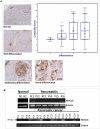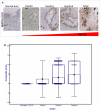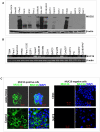Pathobiological implications of MUC16 expression in pancreatic cancer
- PMID: 22066010
- PMCID: PMC3204976
- DOI: 10.1371/journal.pone.0026839
Pathobiological implications of MUC16 expression in pancreatic cancer
Abstract
MUC16 (CA125) belongs to a family of high-molecular weight O-glycosylated proteins known as mucins. While MUC16 is well known as a biomarker in ovarian cancer, its expression pattern in pancreatic cancer (PC), the fourth leading cause of cancer related deaths in the United States, remains unknown. The aim of our study was to analyze the expression of MUC16 during the initiation, progression and metastasis of PC for possible implication in PC diagnosis, prognosis and therapy. In this study, a microarray containing tissues from healthy and PC patients was used to investigate the differential protein expression of MUC16 in PC. MUC16 mRNA levels were also measured by RT-PCR in the normal human pancreatic, pancreatitis, and PC tissues. To investigate its expression pattern during PC metastasis, tissue samples from the primary pancreatic tumor and metastases (from the same patient) in the lymph nodes, liver, lung and omentum from Stage IV PC patients were analyzed. To determine its association in the initiation of PC, tissues from PC patients containing pre-neoplastic lesions of varying grades were stained for MUC16. Finally, MUC16 expression was analyzed in 18 human PC cell lines. MUC16 is not expressed in the normal pancreatic ducts and is strongly upregulated in PC and detected in pancreatitis tissue. It is first detected in the high-grade pre-neoplastic lesions preceding invasive adenocarcinoma, suggesting that its upregulation is a late event during the initiation of this disease. MUC16 expression appears to be stronger in metastatic lesions when compared to the primary tumor, suggesting a role in PC metastasis. We have also identified PC cell lines that express MUC16, which can be used in future studies to elucidate its functional role in PC. Altogether, our results reveal that MUC16 expression is significantly increased in PC and could play a potential role in the progression of this disease.
Conflict of interest statement
Figures




References
-
- Jemal A, Siegel R, Xu J, Ward E. Cancer statistics, 2010. CA Cancer J Clin. 2010;60:277–300. - PubMed
-
- Kloppel G, Lingenthal G, von BM, Kern HF. Histological and fine structural features of pancreatic ductal adenocarcinomas in relation to growth and prognosis: studies in xenografted tumours and clinico-histopathological correlation in a series of 75 cases. Histopathology. 1985;9:841–856. - PubMed
-
- Andrianifahanana M, Moniaux N, Batra SK. Regulation of mucin expression: mechanistic aspects and implications for cancer and inflammatory diseases. Biochim Biophys Acta. 2006;1765:189–222. - PubMed
Publication types
MeSH terms
Substances
Grants and funding
LinkOut - more resources
Full Text Sources
Other Literature Sources
Medical
Research Materials
Miscellaneous

